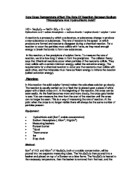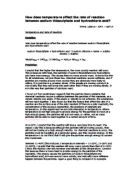Enable for a reaction to start, there must be enough activation energy to break the energy barrier. The energy barrier is the level of energy needed to start a reaction, in other words the amount of energy needed to break the bonds between the particles to create a reaction. The activation energy on the other hand, is the energy needed to start a reaction i.e. lighting a Bunsen burner, which will hopefully break up existing bonds between particles. Therefore the increase in temperature increases the kinetic energy in the particles and so the time taken for a reaction to start also increases.
Plan:
Before I start the actual experiment of the coursework, a few preliminary experiments would help me to understand more about what amounts of chemicals I should use, the range of readings I will investigate and how these can help me to produce a reliable set of result to put on a graph. It also helps me to plan for my final investigation.
Enable for me to investigate the effect of temperature on the rates of reaction I will heat the sodium thiosulphate to the temperatures planed, then place it on a piece of paper with a cross drawn in the middle, add the hydrochloric acid and time how long for the solution to go cloudy enough that you cannot see the cross anymore.
Once I have done a practical to get use to the procedure, I will carryout another one to correct the mistakes I have made and also to improve areas in which I think it can increase the accuracy of the experiment.
Fair test:
- Use the same cross for all experiment so the timing of when the cross disappears won’t vary.
- Record the readings to the same significant figures, e.g. to 2 decimal places etc.
- Use the same volume of concentration throughout the whole experiment.
Prediction:
Since the rate of reaction is the speed at which a chemical reaction takes place, I predict that if I increase the temperature of the reaction, the speed at which the reaction is going to occur will also increase. This is cause by the molecules becoming thermally active, which increases the collisions between particles and so the bonds breaks more quickly. This increase of speed at which the bonds break also increases the reaction, so the speed at which the reaction takes place in a given time accelerates.
On the other hand, if the temperature decreases then the rate at which the reaction takes place will also decrease because there are no movement/ collisions amongst the molecules to create enough energy to break the energy barriers to start a reaction, in other words there is not enough kinetic energy to break the existing bonds between the molecules. In this case the reaction will only take place when hydrochloric acid is added to the sodium thoisulphate, as sodium is alkaline when it mixes with the hydrochloric acid an exothermic reaction takes place. As exothermic reactions give out heat, it means that the bonds between the molecules would break off because heat gives the molecules kinetic energy and this energy is used to break the bonds between the particles.
However, a period of time is needed for this to happen, as only a fairly small amount of heat is heat given off in the solution so it would take a while for the kinetic energy to spread out across to all molecules, so the time taken for the reaction to take place will be much slower than that of a heated flask.
Safety precautions:
Wear goggles to protect eyes, especially since the experiment involves acid. Wear a lab coat to prevent the chemicals from harming you. Take great care when handling the Bunsen burner and use a set of tongs to take the flask off the heat to prevent burns.
Apparatus:
- 250 ml conical flask
- 50 ml measuring cylinders
- Beaker
- Bunsen burner
- Heatproof mat
- Tripod
- Wire gauze
- Stop clock
- A pair of tongs
- Thermometer
Method:
- Measure and pour 50 ml* of sodium thiosulphate solution into a conical flask.
- Heat or freeze the solution to the temperature required. A thermometer is used to measures the solution.
- After heating the solution to the required temperature take the flask off the heat, using tongs and place it over the cross.
- Add 5 ml of hydrochloric acid to the solution and start the stop clock, the give the flask twill.
- Time how long it takes for the cross to disappear then stop the stop clock.
*The volume of the sodium thoisulphate varied for each experiment.
Preliminary Experiment 1
Results:
Volume of concentration: 50 ml of sodium thoisulphate
5 ml of hydrochloric acid.
Evaluation:
The readings in the table is not very spread out, there is only an approximate 10 seconds of difference between each planned temperatures on the table. The readings need to be more spread out enable for me to compare the speed at which the chemicals react. By adding water to the thiosulphate can make the solution more dilute, it also spreads out the readings more as the time taken for the cross to disappear would be longer because there is more molecules in the flask to heat up.
The range of readings displayed on the table does not seem enough to make a reliable set of results. To overcome this problem the range of temperatures can be extended, a wider range of readings could make the results more comparable, reliable and accurate.
Preliminary Experiment 2
Results:
Volume of concentration: 25 ml of sodium thiosulphate
25 ml of water
5 ml of hydrochloric acid
Evaluation:
I have added water to the solution to make it more dilute, the readings did indeed became more spread out. Since I have diluted the solution to a half, the time taken for the cross to disappear should now double, but according to the table only a few did e.g. at 20 c. This shows that some errors have occurred in the experiment, which is why the readings don’t match. It could be that the stopwatch was started late or some careless mistakes made by me. I have to take this into account when I do my final experiment.
The accuracy of the results could be improved further if I have recorded the readings to 2 decimal places instead of none at all. By recording it to 2 decimal places the results are more likely to be more accurate as it involves more detailed.
Final Experiment
Volume of concentration: 40 ml water
10 ml sodium thoisulphate







